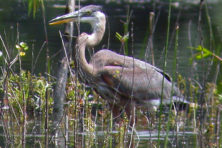Door to Nature: The Great Egret
- Share
- Tweet
- Pin
- Share

Large wading birds are in the Ardeidae family, which includes bitterns, herons and egrets. The family name is derived from the Latin “arde,” meaning a heron. This group is known for having slow flight and a straight bill with the head pulled back over a curved neck. Most of these birds nest in colonies.
The great egret, Ardea alba, can be found in many wetlands along the Mississippi River basin, in ponds, streams, marshes and mudflats. We have been seeing a few more of them each year in Door County because their population seems to be expanding northward.
These graceful, tall, white wading birds were commonly nesting in the South and lower Midwest years ago. After the nesting season, some would fly north – even as far as southern Canada – to find food in shallow wetlands. My late husband, Roy, saw his first great egret in the Kewaunee River marsh in the early 1950s.
The first Atlas of Breeding Birds of Wisconsin, published in 2006, showed that there was fairly good nesting in the state: in sloughs along the Mississippi River; in Horicon Marsh, where one nest was first discovered in 1943; and along the shore of the Green Bay waters. The ban on DDT has helped these and other waterbirds to improve their health.
Horicon Marsh has been the most common site for egrets to nest. During the early 1970s, about 250 pairs bred on Fourmile Island in the southern section of the preserve. However, by the late 1970s, only five nesting colonies were found in our entire state. In late May 1998, a terrible wind storm destroyed many trees in the Horicon Marsh rookery, where 550 nesting pairs of great blue herons and great egrets had been counted the previous year.
The beautiful, white feathers that develop during the breeding season, called aigrettes, were prized and collected during the late 1800s for use in women’s hats. Many egrets were killed just for that purpose until the National Audubon Society claimed the species as its symbol and brought an end to that activity.
Great egrets breed on a few islands in the lower Green Bay waters. They build stick nests from 10 to 50 feet high in trees near the shoreline or in tall shrubs. Their diet consists of small fish, reptiles, amphibians and aquatic invertebrates such as snails and crayfish.
I remember our first visit to Everglades National Park in 1977. We entered at Florida City to walk on the Anhinga Trail, and many photographers were there, aiming long-lensed cameras at the variety of water birds. One that drew a lot of attention was the great white heron. It used to be considered the white form of the great blue heron, but it is now known as a distinct species that’s seen along the saltwater coasts of southern Florida.
Both the great white and great blue herons are 38 to 54 inches in length and have a wingspread of 66 to 79 inches. The great egret is 37 to 41 inches in length, with a wingspread of 50 to 57 inches – considerably smaller than the great herons.
Great egrets may nest as a single pair or in a colony in dense shrubs or trees, sometimes within a great blue heron rookery. They do not breed until their third year and have just one clutch per season. Perhaps the egrets we are seeing come from last year’s nests in other parts of Wisconsin.
We know that the flocks of white pelicans seen soaring over Door County are nonbreeding youngsters hatched last year. I think of these young birds as “teenagers” that are cruising about in their youthful, carefree, pre-breeding stage.
The etymology or derivation of wildlife names intrigues me. The Dictionary of Word Roots and Combining Forms by Donald J. Borror says that “egretta” is a form of heron, and the word just before that, “egresso,” means “watchful.”
When you see a great egret wading through shallow water, it moves very slowly or may stand in one place for a long time. It is being “watchful” for any small fish, reptile or amphibian to come close so it can stab its long bill into the water to catch it.
Get out to enjoy watching the graceful, beautiful great egrets – these splendid birds of the heron world – in your favorite quiet, backwater Door County spot.




